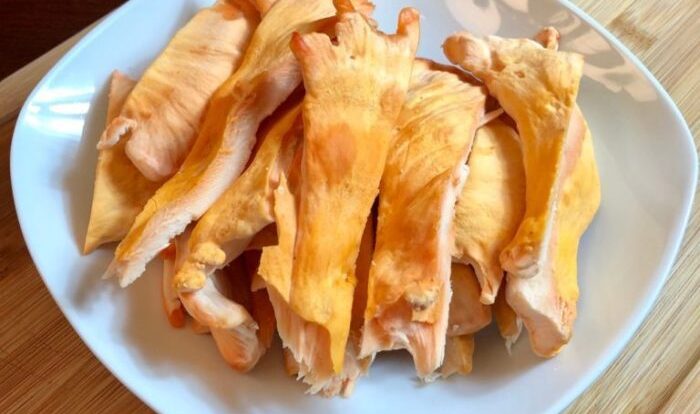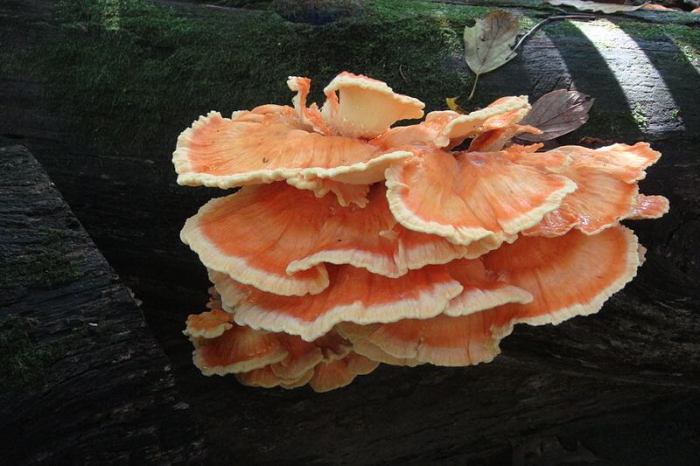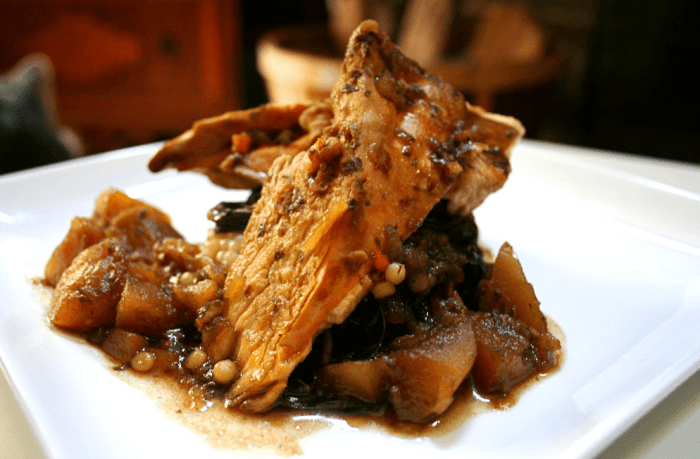
Chicken of the woods recipe, a delectable culinary gem, beckons you to embark on a gastronomic adventure. This vibrant fungus, bursting with flavor and versatility, invites you to explore its hidden potential in the kitchen.
Chicken of the woods, with its striking appearance and tantalizing aroma, has captured the hearts and taste buds of food enthusiasts for centuries. Join us as we delve into the secrets of this culinary treasure, from its identification and harvesting to its preparation and delectable applications.
Chicken of the Woods Identification and Characteristics
Chicken of the Woods is a vibrant and distinctive mushroom that has captured the attention of foragers and mushroom enthusiasts alike. Its appearance and characteristics set it apart from other mushrooms, making it easy to identify in the wild.
This mushroom typically grows in shelf-like clusters on the sides of trees, particularly oak and beech trees. Its bright orange to yellow color and its firm, meaty texture are key identifying features. The pores on the underside of the mushroom are also a distinguishing characteristic, as they are small and white.
Growth Habits and Habitat
Chicken of the Woods is a saprobic fungus, meaning it derives its nutrients from decaying organic matter. It is commonly found in deciduous forests, especially in areas with high moisture levels. The mushroom’s growth habit is parasitic, as it feeds on the decaying wood of living trees.
This can lead to the eventual decay and death of the host tree if the infection is severe.
Edibility and Look-alikes
Chicken of the Woods is considered edible and is often sought after by mushroom hunters. Its meaty texture and mild flavor make it a versatile ingredient in various culinary preparations. However, it is crucial to note that there are look-alike species that can be toxic.
One such look-alike is the Laetiporus sulphureus, which has a similar appearance but is poisonous and should be avoided.
To ensure safe consumption, it is essential to positively identify the mushroom before eating it. Consulting with experienced mushroom foragers or using reliable field guides is highly recommended to avoid any potential risks.
Harvesting and Cleaning Chicken of the Woods

Harvesting Chicken of the Woods requires careful consideration of its maturity, habitat, and proper techniques to preserve its freshness and edibility. Cleaning the mushroom involves removing any debris or dirt that may have accumulated during its growth.
Harvesting Techniques
- Identify Mature Specimens:Harvest Chicken of the Woods when it is fully grown and has developed its characteristic orange or yellow color. Avoid picking young or underdeveloped mushrooms.
- Use a Sharp Knife:Cut the mushroom at the base of the stem, leaving a small portion attached to the tree or ground. This helps prevent damage to the mycelium and allows the mushroom to continue growing.
- Handle with Care:Chicken of the Woods is delicate and can bruise easily. Handle it gently to avoid damaging its flesh.
Cleaning Methods
- Brush Away Debris:Use a soft-bristled brush or a damp cloth to gently remove any dirt, leaves, or other debris from the surface of the mushroom.
- Rinse with Water:If necessary, rinse the mushroom briefly under cold running water to remove any remaining debris. Avoid soaking it in water, as this can make it soggy.
- Dry Thoroughly:After cleaning, pat the mushroom dry with a paper towel or allow it to air dry before storing or cooking.
Optimal Harvesting Conditions
Chicken of the Woods is typically found in the fall, from late summer to early winter. It prefers moist, shady areas, such as forests and woodlands. Look for it on the base of trees, particularly oak, beech, and maple.
Cooking Methods for Chicken of the Woods

Chicken of the woods is a versatile mushroom that can be cooked in various ways. Each method imparts unique flavors and textures, allowing you to enjoy the mushroom’s versatility. Here are some popular cooking methods and their advantages and disadvantages:
Grilling
Grilling imparts a smoky, charred flavor to chicken of the woods. It’s a great option for creating a savory, juicy dish.
-
-*Advantages
Chicken of the woods is a delicious and versatile mushroom that can be used in a variety of dishes. One popular way to prepare chicken of the woods is to fry it. Here’s a recipe for fried chicken of the woods that is sure to please everyone at your table.
Quick and easy to prepare, enhances flavor with smoky notes, creates a crispy exterior while maintaining a tender interior.
-*Disadvantages
Requires careful monitoring to prevent burning, may not be suitable for large quantities.
Sautéing
Sautéing is a versatile method that allows you to control the cooking temperature and add various seasonings and ingredients.
-
-*Advantages
Quick and convenient, allows for customization of flavors, preserves the mushroom’s texture.
-*Disadvantages
Requires constant stirring to prevent sticking, may not be suitable for large quantities.
Roasting
Roasting chicken of the woods in the oven caramelizes the edges and creates a rich, earthy flavor.
-
-*Advantages
Enhances the mushroom’s natural sweetness, suitable for large quantities, allows for easy cleanup.
-*Disadvantages
Requires longer cooking time, may result in a drier texture if overcooked.
Frying, Chicken of the woods recipe
Frying creates a crispy, golden-brown exterior and a tender interior. It’s a great option for creating a satisfying and flavorful dish.
-
-*Advantages
Quick and easy, adds a crispy texture, allows for customization of flavors with different coatings.
-*Disadvantages
Requires additional oil, may not be suitable for those with dietary restrictions.
Flavor Profile and Culinary Applications
Chicken of the Woods boasts a unique and distinctive flavor profile that sets it apart from other mushrooms. Its meaty texture and savory umami notes make it an excellent substitute for chicken in various dishes. The flavor is often described as a combination of nutty, earthy, and slightly sweet, with a hint of seafood-like brininess.
This versatile mushroom can be cooked in numerous ways, lending its distinctive taste to a wide range of culinary creations.
Complementary Ingredients and Seasonings
To enhance the flavor of Chicken of the Woods, consider pairing it with complementary ingredients and seasonings. Herbs such as thyme, rosemary, and oregano complement its earthy notes, while garlic and shallots add depth and richness. A squeeze of lemon juice or a splash of white wine can brighten the flavor, and a touch of soy sauce or miso paste can add umami.
If you’re looking for a healthier way to prepare chicken of the woods, you can try roasting it. This recipe for roasted chicken of the woods is simple and easy to follow, and it results in a delicious and flavorful dish.
For a smoky flavor, grill or roast the mushrooms over an open flame or in a smoker.
Versatility in Various Cuisines and Dishes
Chicken of the Woods’ versatility extends to various cuisines and dishes. In Italian cooking, it can be sautéed with garlic and olive oil and served over pasta or polenta. In Asian cuisine, it can be stir-fried with vegetables and a savory sauce, or added to soups and stews for a meaty flavor.
In Mexican cuisine, it can be used as a filling for tacos or quesadillas, or grilled and served with a salsa.
Nutritional Value and Health Benefits

Chicken of the Woods is not only delicious, but it is also packed with essential nutrients. It is an excellent source of dietary fiber, which is important for maintaining a healthy digestive system. It is also a good source of protein, vitamins, and minerals, including vitamin C, potassium, and iron.
Antioxidant Properties
Chicken of the Woods contains several antioxidants, including ergothioneine and glutathione. These antioxidants help protect cells from damage caused by free radicals, which can contribute to chronic diseases such as cancer and heart disease.
End of Discussion

As we bid farewell to our culinary journey with chicken of the woods recipe, let us remember the unique flavors and endless possibilities it offers. From its vibrant orange hue to its meaty texture, this forest delicacy has left an indelible mark on our palates.
Whether you’re a seasoned chef or a culinary novice, the chicken of the woods recipe is an invitation to explore the boundless realm of nature’s culinary wonders. Embrace its versatility and let your creativity soar as you craft dishes that will tantalize your taste buds and leave a lasting impression on your guests.
Questions and Answers: Chicken Of The Woods Recipe
Is chicken of the woods safe to eat?
Yes, chicken of the woods is safe to eat when properly cooked. It is important to note that some people may be allergic to mushrooms, so it is recommended to consume it in moderation.
How can I identify chicken of the woods?
Chicken of the woods is typically bright orange and has a velvety texture. It grows in clusters on trees and can be found from spring to fall.
What is the best way to cook chicken of the woods?
Chicken of the woods can be cooked in a variety of ways, including grilling, sautéing, roasting, and frying. It is best to cook it until it is tender and has a slightly crispy exterior.





